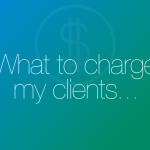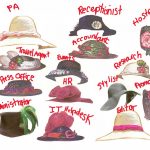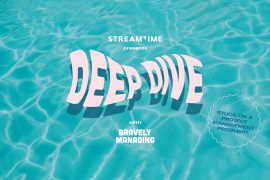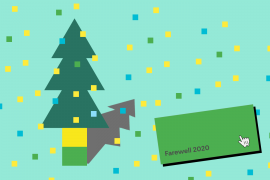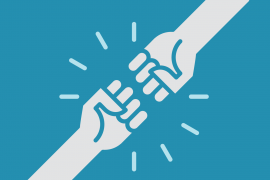
For this episode of It’s About Time we’re in the studio with Simon Hipgrave Founder and Creative Director of The Hungry Workshop. We talk about the challenges of starting a business, the joys of the letterpress and printing with Vegemite.
Like this podcast? You can find other insightful episodes on iTunes or at itsabouttime.simplecast.fm
Alternatively, if you’d prefer to read Simon’s insights, here’s an edited transcript of our conversation.
It started with a passion
Kye: I cannot tell you how excited I actually am to be here, you guys can’t see this but we are surrounded by the printing presses and I am just in heaven. So, I guess I just wanted to start with, what drove you to start this business?
Simon: It started off as a hobby really, as a passion project. We had a neighbour who was venturing up to the Sunshine Coast in Queensland, we lived in Brisbane at the time and she would go up and do letter press printing at an old historical village. Jenna got talking to her and it sounded interesting to her so Jenna started going up as well. Jenna and I, we have a creative background we both studied design and she was working at a design studio at the time and I was working at an ad agency. She would go up every weekend. It was the kind of place where they had an old dairy, where they had all the old machinery and there was an old engineering shop where they would fix up trucks and things like that and then they had the old print shop. The old print shop was the only place there that was really, really kind of humming along. I used to rip on Jenna a little bit and ask if she had to speak in the Old English when she was there. I didn’t really get it.
She coaxed me into going up one weekend and I went into this print shop, it was a little tin shed in rural Brisbane, out of skirts Brisbane and it was just humming, the whole place was full of machinery from floor to ceiling and these two old retired printers, Ken and Bob, were in there and they were really passionate about what they were doing. They would just print and they would teach anybody who was willing to learn and kind of pass on their art, their life’s work. They were very contagious people.
Kye: That sounds amazing!
Simon: Yeah, it was really, really good. So, Jenna invited me up and I came up and had a look around. They showed us some of the equipment, we got printing. We started going up every Saturday, then we started going up every Saturday and Sunday, then we started going up in the evenings and we got a bit carried away with it. It was just a hobby forever and like I said the shed was full of equipment and one day as we were leaving, they were like, “You guys really like this printing stuff, don’t you?” and we said, “Yeah,” and they said, “Would you like one of these printing presses, we’ve got too many.”
“We started going up every Saturday, then we started going up every Saturday and Sunday, then we started going up in the evenings and we got a bit carried away with it.”
Kye: No way!
Simon: Yeah, so we laughed and left and kind of joked to ourselves, wouldn’t that be crazy, if we got a printing press what would we do with it, where would we go, where would we put it, because we lived in a little two bedroom apartment and the printing presses are one and half tons. We had nowhere to put it, so we just kind of laughed it off, and then in the morning we thought actually we should do this and two weeks later we had a crane truck lowering this printing press into my parents living room, which was much more accessible then our two bedroom apartment, and told them it would only be two weeks,it was there for a while. Yeah, that’s kind of how it all got started, we started from this offer of this printing press and we thought you know what we could do this, make a job out of it.
Kye: So, then the move to Melbourne, how did that come about?
Simon: Yeah, so, we had been kind of working our jobs for a while and we had just gotten married and we kind of already had set in our minds that we were going to do something else. Initially it was going to be a move to the US where Jenna is from and the GFC happened and it kind of kyboshed those plans. So, we were mentally prepared to leave and try something else. So, when we decided to start the Hungry Workshop. We thought, “Look let’s do that somewhere else, let’s do it in Melbourne.” So we kind of started the business and moved all at the same time. It took us about eight to twelve months to get down here and get up and running properly but it was a really good journey.
Kye: That’s an amazing story. Did you just originally start it to be a letter press business or was the design side always going to be a part of it?
Simon: Yeah, the design side’s super important to what we do. Part of the joy that we first discovered when we were up there printing was getting the design project, your own creative work, your own idea, you’ve designed it, you’ve put a lot of thought and effort into it and then actually going and producing that and it was that complete picture that really lit us up, from a design perspective…from an advertising perspective where I was working at an agency, it was a reasonable sized agency. We’d spend months and months and months and thousands of dollars and there would be arguments and there would be tears and people would be turning grey and it would all boil down to 30 seconds of airtime.
“There is something really physical and tactile about getting back to basics of just producing something that you printed yourself or designed yourself and having a hand in manufacturing it.”
It was so intangible at the end of it. It was a really fun process and I really, really loved working in that industry but there is something really physical and tactile about getting back to basics of just producing something that you printed yourself or designed yourself and having a hand in manufacturing it. The design is really important and we love design, that’s kind of why we moved to Melbourne because there are so many great studios to work with down here. We get really excited when we see other people’s design, we get really excited about having a hand in bringing that stuff to life. I think, the design is just as important as the making.
Collaboration
Kye: When you collaborate with other design studios and they come in with their work, is there ever a case of envy? Do you ever say, “Oh, I wish I had done something that”?
Simon: All the time, that’s kind of what gets us excited. We love working with guys like TCYK and Rhys. Everything they send our way usually blows us away. I think that’s the other half of the reason to get up in the morning, is to see all this work before anybody else gets to see it and work with people we admire and…
Kye: Bring it all to life…
Simon: Yeah.
Kye: When it comes to clients, are you choosy? Do you take whoever comes along? Do you have a particular kind of client you are trying to attract?
Simon: Look, with the way that we print…letter press printing is really labor intensive, it requires a lot of resources to do it properly. It’s not the cheapest way of producing stuff. The work that we get is naturally people’s best work. They’ve got a client that they love, they’ve put a lot of thought and effort into the design. They really want to finish a project with a super high level of attention to detail and finishing and make it look fantastic. So, you naturally get clients who are really driven and really excited about their projects, so they are a good quality client, usually.
Kye: I guess when a client comes to you, they have their final product vision of it and how it’s going to look and stuff. Do they quite often know what kind of stock they want to use and things like that or is that where you guys can come in and…?
Simon: Yeah, we help them with that. There’s stocks and design for letter press printing which work really, really nicely. One of the beauties of letter press printing is the fact that it’s just such a simple process. It’s just relief printing so you get a reverse image and that’s converted into a raised plate, that plate is inked and pressed into the paper. It’s like a giant stamping machine. So, what that means is, we can feed any paper through the press, it works off a flat bed, so the paper doesn’t go around a roller. So we can print on 1200 gram box board all the way down to super thin paper like the yellow pages. We can print on anything, which is quite fun. I think you can be expressive with the paper that you choose. We did a project on yellow pages which was fun. We’ve done projects where we’ve got children’s storybooks and cut the spines off and fed that paper through the press. You can be really experimental with that as well.
Printing with Vegemite and wine
Kye: Tell me about the Vegemite.
Simon: Vegemite that was a really great project. A friend of mine who I used to work with at Brisbane was working down here at an ad agency and we kind of collaborated on the job to print with Vegemite for Vegemite. It was a really great job. Again, that’s another one of the advantages of this process is that the ink goes in an inkwell up the back, there’s no propriety cartridges, anything that’s kind of inky and gooey, you can put it in the inkwell and give it a crack. So, we’ve printed with Vegemite, which was super fun and a real kind of bucket list project and we’ve also printed with wine before. We’ve boiled wine down and created an inky kind of substance, so that’s always good fun to experiment with that kind of stuff.

Learning the business of the business
Kye: Okay, so you and Jenna are designers, from a design background, you were working for other people and you started this business. Did you find the business side of things challenging to stay creative, you want to do all these amazing things, but you’ve got a business to run?
Simon: Yeah, totally. The business side of things was definitely challenging, it was something that we had to learn as we went. We are really fortunate to have found a really great kind of management consultant. It was really funny we were actually printing up business cards for a guy called John Calabro from The View from Here. He’s a really fantastic designer, he designed these cards and sent the job to us. We were printing them and literally the card was coming off the press and I picked it up, read the card and was like, “I need to call this lady,” and I called her up. So, she’s been very helpful with all sorts of management duties and helps us understand the business side of things.
“There’s a vast difference between having worked with people and worked in teams than there is to working with people and managing teams and managing people.”
There is absolutely a huge learning curve. Like I said before, there’s a vast difference between having worked with people and worked in teams than there is to working with people and managing teams and managing people. So yeah, it’s definitely been a learning curve. I think we’re kind of fortunate that Jenna and I have different skill sets and different approaches. We’re both from the creative industry, the creative field, but my experiences with our direction was more conceptual big picture stuff. I worked in a team where we had finished artists and designers, so I could do the rough, get it down and send it off. Whereas Jenna was working in a really small studio that was about four or five people there and had to do things like spell check their documents, which I often neglected to do. Jenna is much more detail-oriented and I’m much bigger picture, which means we’re not always fighting to do the same sort of tasks. She’s always kind of had a penchant for filling out forms and admin stuff so she took control of most that stuff, which was really fantastic.
Kye: Do you have any advice for people that might be wanting to start up and progress…you know they might just be a sole trader for now but down the track they might get a bit busier and might only ever be two of them but it’s still a business that they’ve got to run.
Simon: Yeah, I think take it slow, that would be my advice, take it slow and don’t over capitalise.
The future of AGDA
Kye: Yourself and Jenna are involved in AGDA. I deal with AGDA from time to time and I know that funding can be a bit of a problem, they are always looking for sponsorship to put on these amazing talks in the different States, the Biennale and stuff like that. Do you think an organisation like AGDA is still relevant today?
Simon: Yeah, absolutely. Jenna has been on AGDA committee for four or five years straight. She did three or four years in Brisbane and I think a year or two down here in Melbourne. So, we’ve been in and around AGDA for a long time. I believe that it’s an organisation that we desperately need as an industry and I think it’s the kind of thing where the more you put in the more everybody will get out. I think it’s a real community issue. I think if AGDA is doing a bad job then we’re doing a bad job as an industry. I think they are a body that is supposed to represent us and if people think they…I know there was some criticism about their relevance or if they’re doing a bad job or…I think it’s all a reflection of the industry at large and if you’re feeling under represented or under serviced, then get in there and change it, pitch in and help out and do it for everybody.
“It’s an organisation that we desperately need as an industry.”
Kye: I feel like there seems to be so many organisations and things that are just popping up and offering creative talks and creative advice. I feel sort of like there’s a lot of competition at the moment. Every other weekend there seems to be a seminar or something design-like on and they aren’t cheap. Particularly for someone who has just graduated. It fees like today’s creative needs to pick and choose which events they are going to go to. Having said that, I’m from Sydney and I have seen some fantastic talks. I know AGDA Victoria are coming up with a new design business thing in September and that sounds fantastic as well. I just wanted to know from someone who’s been a part of that…
Simon: I think there was a time where AGDA were the only people doing those kind of talks and I think they really paved the way and created the market for them. Now that they do have competition I think their job is done in that space and now they can move on to other stuff. I don’t think they need to be competing with those people. I think AGDA did a really great job in creating that. I’m not saying AGDA shouldn’t do talks, but I’m saying it shouldn’t be their focus. One of big things…you look at other industry bodies and I think AGDA could take a note from the architecture industry, what the architecture industry does to support and control their industry is really, really fantastic. And I think accreditation would be really wonderful just considering how accessible design is becoming, with the proliferation of the tools, the tools are becoming easier to use. To have someone who really puts the time and the effort into to thinking about a brand or thinking about design, thinking about a project, I think accreditation would be really, really valuable and I think that’s potentially the next big challenge for AGDA.
“I’m not saying AGDA shouldn’t do talks, but I’m saying it shouldn’t be their focus.”
Kye: Hopefully they’re up to it, I know they would be.
Simon: Yeah, I know there’s going to be talk about it for some time now but the industry is changing and AGDA needs to change with. It will change if the people who are practicing are involved in it. It will always reflect the people who are involved in it.
Inspiration and mentorship
Kye: What or who inspires you, to get up every day and come in here to create this beautiful work?
“The industry at large in Melbourne is really inspiring, there’s lots of fantastic work being produced.”
Simon: That’s a good question. I don’t know. I think on a day-to-day, current inspiration, I think just the industry at large in Melbourne is really inspiring, there’s lots of fantastic work being produced. We love being involved in it. I get excited about getting emails and seeing artwork before and seeing how we can help people bring it to life. I think mentorship is really important and I’ve had some really fantastic mentors over my career and I always think back to what those guys would do in my situations and they’re always a big inspiration for me, that would be Bob and Ken who taught us how to print. They taught us the right way to do it and then they taught us how to break the rules and kind of push the boundaries with it, which was really fantastic.
Kye: Yeah, mentorship I feel like it’s a very important thing. Not a lot of people are lucky enough to have a good mentor and I think there’s a lot of people out there who would like to mentor people…
“I think there’s always a case for doing work that builds your portfolio but there’s also a case for working in a place that builds you as a person.”
Simon: I think whether you have a formal arrangement or not, everybody has a mentor. Everyone who is in a senior position is essentially a mentor to those who work under them.
Kye: Well, they can be, if they choose to be.
Simon: You either get a good influence or a bad influence. I think it’s really important for people who are starting out in the industry to find a place where they want to work, but particularly find somebody who they want to work with, who they value their opinions of and who feel like they can teach them a lot and kind of grow and improve and be better. I think there’s always a case for doing work that builds your portfolio but there’s also a case for working in a place that builds you as a person and builds your skill set as a wider idea.
Best piece of advice
Kye: Finally, what’s the best piece of advice that you’ve been given?
“Try everything twice.”
Simon: Try everything twice.
Kye: Nice and simple, I like it. That’s a great bit of advice. Well, thank you so much for having us, I could talk to you all day…
Simon: Oh, it’s a pleasure, thank you for coming down.



